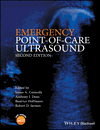Intravascular Volume Assessment by Ultrasound Evaluation of the Inferior Vena Cava
Summary
Ultrasound evaluation of inferior vena cava (IVC) diameter and collapse was initially investigated by nephrologists for use with dialysis. With respect to the cardiac cycle, the IVC is at its most collapsed immediately after opening of the tricuspid valve in early diastole, and most distended at the time of atrial contraction at the end of ventricular diastole. The IVC is best visualised with a 2-4 MHz phased-array or curvilinear probe. A variety of sites have been used to measure the IVC, including the caval-right atrium (RA) junction, inferior to the junction of the hepatic veins, and at the take-off of the left renal vein. Assessment of the IVC is made both qualitatively (shape) and quantitatively (absolute size and collapse index). By impeding venous return into the thorax it increases IVC diameter, and by reversing the usual pressure changes through the respiratory cycle it undermines the utility of IVC-collapse index (IVC-CI) assessment.



